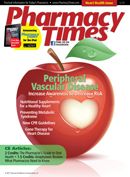Publication
Article
Pharmacy Times
Cycloset® (bromocriptine mesylate) Tablets: A Novel Treatment for the Management of Type 2 Diabetes in Adults
Cycloset (quick-release formulation of bromocriptine mesylate), a dopamine D2 agonist, is a novel agent recently approved by the FDA for type 2 diabetes mellitus.
This article was brought to you by

Introduction
Diabetes mellitus (DM) is a chronic metabolic disorder caused by inadequate insulin secretion, insulin resistance, or both.1 It is characterized by hyperglycemia, which can lead to microvascular and macrovascular complications, such as neuropathy, retinopathy, nephropathy, and cardiovascular disease (CVD) due to hypertension and dyslipidemia, if it persists for a prolonged period of time.2 Type 2 DM (T2DM) is the most prevalent type of diabetes, accounting for 90% to 95% of all cases.1
Pathophysiology and Treatment
Six dysfunctional processes have been identified as central to the pathophysiology of T2DM; they occur in the pancreas, liver, peripheral tissues, gastrointestinal (GI) tract, adipose tissue (visceral fat), and brain.3 In the early stages of prediabetes, pancreatic beta-cells release higher than normal amounts of insulin in response to elevated postprandial glucose (PPG) levels; this may be due to accelerated GI motility.4 Increased hepatic gluconeogenesis results from hyperactive pancreatic alpha-cell glucagon stimulation and leads to decreased peripheral tissue sensitivity (ie, insulin resistance). Nocturnally, elevated blood glucose levels decline, resulting in normal fasting plasma glucose (FPG) levels. Over time, however, elevated PPG levels lead to excessive insulin demand, causing pancreatic beta-cell function to deteriorate. FPG levels increase due to lower insulin production and output and continued hepatic glucose production.
By the time a patient is diagnosed with T2DM, they have most likely had the disease for 9 to 12 years, and only 20% to 50% of pancreatic beta-cells are functional.3 Patients with T2DM often mention that they are always hungry and never feel full after eating. This is due to insufficient amylin secretion from the pancreatic beta-cells, resulting in diminished satiety signals to and from the brain. It may also be the result of accelerated GI motility.4 Furthermore, excess adipose tissue (ie, a large waist circumference), commonly observed in T2DM, raises inflammatory markers such as tumor necrosis factor-alpha, interleukin-6, and C-reactive protein, which are all associated with insulin resistance.5,6 In addition, recent studies have demonstrated decreased dopamine levels in the brain, as evidenced by elevated prolactin levels, in individuals with T2DM. These decreased dopamine levels lead to changes in the hypothalamus, which are thought to result in overstimulation of hepatic glucose production, lipolysis, and increases in peripheral insulin resistance.5
Current monotherapy options for T2DM target as many as 4 of the 6 dysfunctional processes. Therefore, combination therapy is often necessary for optimal treatment and management of T2DM. Existing pharmacotherapy strategies include stimulating insulin release, reducing hepatic glucose production, increasing glucose transporter production, and increasing or mimicking glucagon-like peptide-1 activity.3
Cycloset (bromocriptine mesylate) Tablets
Cycloset is a quick-release formulation of bromocriptine mesylate (“bromocriptine-QR”). It is a new formulation of the well-known dopamine D2 agonist, and it is the first and only centrally acting oral antidiabetic agent approved by the FDA for the treatment of adults with T2DM. This formulation of bromocriptine is unique compared with older products such as Parlodel®, and the older formulations are not therapeutically equivalent to Cycloset. In clinical trials, bromocriptine-QR demonstrated consistent glycemic control throughout the day. The once-daily formulation improved PPG levels without increasing plasma insulin concentrations. In the 52-week safety study, 35% to 40% of patients who failed other oral antidiabetics reached their glycosylated hemoglobin (A1C) level goal with bromocriptine-QR within 24 weeks; additionally, bromocriptine-QR has demonstrated cardiovascular safety.7
Bromocriptine-QR also presents a unique proposed mechanism of action to enhance insulin sensitivity, lower PPG levels, and reduce overall A1C levels. It can be used as monotherapy, or in combination with other diabetes medications, in adults with T2DM who are unable to reach their glycemic goals.5
Proposed Mechanism of Action
Studies have suggested that the circadian neuroendocrine rhythm mediated by dopamine and serotonin plays a large role in insulin sensitivity.8 In people without diabetes, the postmeal state causes a decline in endogenous glucose production due to suppression of glucagon and inhibition of lipolysis. In individuals with T2DM, a drop in dopamine levels is thought to lead to an inadequate hypothalamus response, resulting in elevated levels of blood glucose, free fatty acids (FFA), and triglycerides (TG), which contribute to insulin resistance, visceral adiposity, and beta-cell dysfunction. Clinical studies suggest that bromocriptine-QR administered in the morning (within 2 hours of waking) mimics the normal peak of dopamine in the central nervous system, consequently thought to reset this circadian rhythm. The main target organ of bromocriptine is the brain. However, subsequent effects have been observed in adipose tissue (due to decreased levels of glucose, FFAs, and TGs) and the liver (reduced hepatic gluconeogenesis due to reduced cortisol levels in response to dopamine).
Dosing and Pharmacokinetics
Cycloset belongs to a class of sympatholytic dopamine D2 agonists.5 The recommended starting dose is 0.8 mg orally once daily in the morning (within 2 hours of waking). Cycloset can be titrated to a maximum daily dose of 4.8 mg. The appropriate titration schedule is an increase of 1 tablet (0.8 mg) each week to a therapeutic dose between 1.6 and 4.8 mg per day. It is important to note the difference in dosing between Cycloset and Parlodel, as the dosage of Parlodel can be much higher (maximum daily dosage of 100 mg). Parlodel is also dosed multiple times per day in comparison with the once-daily dosing of Cycloset.7,9,10 Following oral administration, 65% to 95% of the Cycloset dose is absorbed, compared with 28% with Parlodel. Due to extensive first-pass metabolism, only 7% of the administered dose of Cycloset reaches systemic circulation. When taken on an empty stomach, maximum plasma concentration (Cmax) is reached within 45 to 60 minutes. Cmax increases to 90 to 120 minutes following a fatty meal. Bromocriptine has a high affinity for the cytochrome P450 (CYP) 3A4 isoenzyme, which has a high potential for drug-drug interactions. Therefore, caution should be taken with concomitant use of any strong substrate, inducer, or inhibitor of this CYP450 isoenzyme. 5,7
Efficacy and Safety in Clinical Trials
In clinical trials, bromocriptine-QR improved A1C (decreases of 0.6%- 1.2%), PPG, and FPG levels when used as monotherapy and as adjunct to other oral diabetes medications, such as a sulfonylurea and metformin.5 A higher percentage of patients given bromocriptine-QR achieved an A1C level less than 7% compared with those given placebo.7 Also, bromocriptine-QR meets the new cardiovascular safety in T2DM pharmacotherapy guidelines set by the FDA. In a 52-week safety study (N = 3070), bromocriptine-QR use was not associated with an increased risk for adverse cardiovascular events.9 A 42% relative risk reduction for composite CVD endpoint versus placebo was observed (hazard ratio = 0.58, 95% confidence interval, 0.35-0.96). A total of 1.5% of patients given bromocriptine-QR experienced a composite CVD endpoint compared with 3% of patients given placebo.7 Based on calculation of the number needed to treat, 79 patients would need to be treated for 1 year to avoid 1 important cardiovascular event.9 The most commonly reported adverse events related to bromocriptine-QR were nausea (mild to moderate), vomiting, fatigue, and headache. These effects, however, appear to be transient (lasting a median of 2 weeks) and generally occurred during the initial titration phase.5 Bromocriptine-QR can also cause hypotension, orthostatic hypotension, and syncope, particularly during initiation and escalation of therapy. Bromocriptine-QR demonstrates weight-neutral effects. The mean change in body weight was 0.2 kg with bromocriptine-QR compared with 0.1 kg with placebo.5
Conclusion
T2DM is a growing epidemic affecting approximately 24 million Americans and consuming nearly 20% of all health care costs.3 It is often referred to as a multiorgan disease which affects the pancreas, liver, peripheral tissue, GI tract, adipose tissue, and brain.3 Due to the complexity of T2DM, combination pharmacotherapy that targets all dysfunctional processes is necessary to control the disease and prevent long-term complications. Currently available agents can help patients manage diabetes in its early stages; however, it becomes more challenging to reach and maintain glycemic goals as time progresses. New, safe, and effective treatment options are necessary to assist in the management of this multiorgan disease. The new bromocriptine-QR formulation in Cycloset, with its novel, centrally acting approach, shows promise in the armamentarium of T2DM treatment options. With demonstrated efficacy, as well as cardiovascular and overall safety, bromocriptine- QR may represent a viable treatment option for adult patients with T2DM.
CYCLOSET is a dopamine receptor agonist indicated as an adjunct to diet and exercise to improve glycemic control in adults with type 2 diabetes mellitus. CYCLOSET should not be used to treat type 1 diabetes or diabetic ketoacidosis. Efficacy data in combination with thiazolidinediones are limited. Efficacy has not been confirmed in combination insulin.
Important Safety Information
CYCLOSET is contraindicated in patients with hypersensitivity to ergot-related drugs, bromocriptine, or any of the excipients in CYCLOSET. Do not use in patients with syncopal migraines. It may precipitate hypotension. Do not use in nursing women. It may inhibit lactation. There are postmarketing reports of stroke in this patient population.
CYCLOSET can cause orthostatic hypotension and syncope, particularly upon initiation or dose escalation. Use with caution in patients taking antihypertensive medications. CYCLOSET may exacerbate psychotic disorders or reduce the effectiveness of drugs that treat psychosis. Use in patients with severe psychotic disorders is not recommended. CYCLOSET may cause somnolence. Advise patients not to operate heavy machinery if symptoms of somnolence occur. Concomitant use with dopamine antagonists such as neuroleptic agents is not recommended.
There have been no clinical studies establishing conclusive evidence of macrovascular risk reduction with CYCLOSET or any other antidiabetic drug. CYCLOSET does not increase the risk of macrovascular events.
In controlled clinical trials, adverse reactions reported in ≥5% of patients treated with CYCLOSET, and reported more commonly than in patients treated with placebo, included nausea, fatigue, dizziness, vomiting, and headache.
Safety and effectiveness have not been established in pediatric patients.
Dr. Cornell is assistant director of experiential education and assistant professor of pharmacy practice at Midwestern University Chicago College of Pharmacy in Downers Grove, Illinois. Ms. Bryk-Gandera is a 2011 PharmD candidate at Midwestern University Chicago College of Pharmacy in Downers Grove, Illinois.
For Full Prescribing Information, click here.
References
1. Rodbard HW, Blonde L, Braithwaite SS, et al. American Association of Clinical Endocrinologists medical guidelines for clinical practice for the management of diabetes mellitus. Endocr Pract. 2007;13(suppl 1):S1-S68.
2. American Diabetes Association. Standards of medical care in diabetes—2010. Diabetes Care. 2010;33(suppl 1):S11-S61.
3. Cornell S, Lullo A. Getting to goal for patients with type 2 diabetes: mission possible. Diabetes Trends. 2009;21(A):2-10.
4. Phillips WT, Schwartz JG, McMahan CA. Rapid gastric emptying of an oral glucose solution in type 2 diabetic patients. J Nucl Med. 1992;33(8):1496-1500.
5. Scranton R, Cincotta A. Bromocriptine — unique formulation of a dopamine agonist for the treatment of type 2 diabetes. Expert Opin. Pharmacother. 2010;11(2):269-279.
6. Pfeiffer AF. Adipose tissue and diabetes therapy: do we hit the target? Horm Metab Res. 2007;39 (10):734-738.
7. Cycloset (bromocriptine mesylate) [prescribing information]. VeroScience, LLC; September 2010. http://cycloset.com/assets/pdfs/cycloset-pi-final. pdf. Accessed November 1, 2010.
8. Meier A, Cincotta A. Circadian rhythms regulate the expression of the thrifty genotype/phenotype. Diabetes Rev. 1996;4:464-487.
9. Gaziano JM, Cincotta AH, O’Connor CM, et al. Randomized clinical trial of quick-release bromocriptine among patients with type 2 diabetes on overall safety and cardiovascular outcomes. Diabetes Care. 2010;33(7):1503-1508.
10. Parlodel (bromocriptine mesylate) [prescribing information]. Novartis Pharmaceuticals Corporation; May 2006. www.pharma.us.novartis.com/product/pi/pdf/parlodel.pdf. Accessed November 16, 2010.
1-CYC10596








